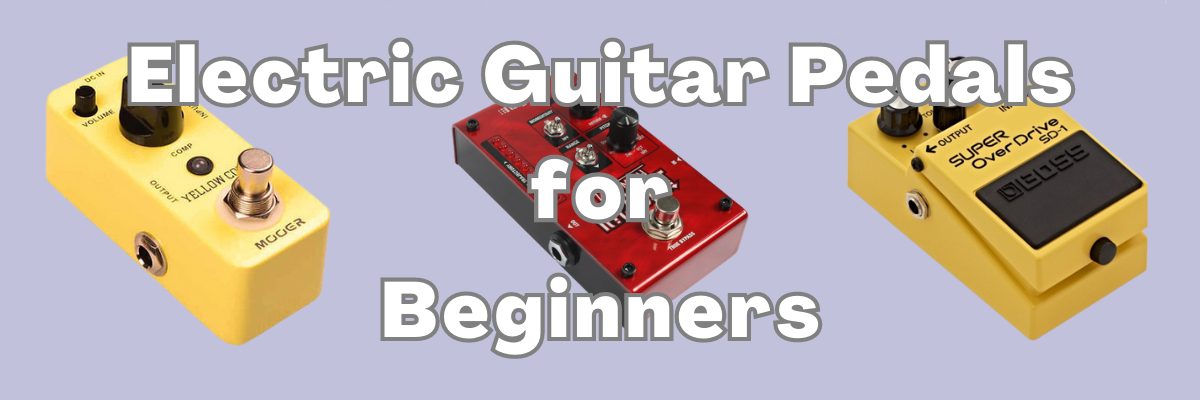Electric Guitar Pedals For Beginners: A Comprehensive Guide.
If you’re looking to explore new sounds and expand your electric guitar’s tone, read on.
Table of Contents
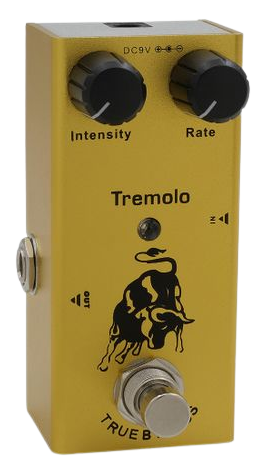
Hi, Ian here, and welcome to this article on electric guitar pedals for beginners!
If you’re new to playing electric guitar, you may be wondering what all those pedals on the floor are for. Well, guitar pedals are electronic devices that can be used to change the sound of your guitar in a variety of ways. They can add distortion, overdrive, fuzz, delay, reverb, and much more.
Pedals can be used to create all sorts of different sounds, from clean and pristine to crunchy and distorted. They can also be used to add effects like delay and reverb, which can create a sense of space and depth in your music.
If you’re just starting, it can be a bit overwhelming to know where to start with guitar pedals. There are so many different types and brands available, and it can be hard to know which ones are right for you.
That’s why I’ve written this article. I’m going to give you a brief overview of the different types of guitar pedals available, and I’ll recommend a few pedals that are good for beginners.
Types of guitar pedals
There are many different types of guitar pedals available, but some of the most common include:
- Distortion pedals: Distortion pedals add grit and sustain to your guitar sound. They’re often used for rock and metal music, but they can also be used in other genres like blues and country.
- Overdrive pedals: Overdrive pedals are similar to distortion pedals, but they produce a less aggressive sound. They’re often used to add warmth and fullness to your guitar sound.
- Fuzz pedals: Fuzz pedals produce a distorted, buzzing sound. They’re often used for psychedelic and alternative music.
- Delay pedals: Delay pedals repeat your guitar signal back to you after a set amount of time. This can create a sense of space and depth in your music.
- Reverb pedals: Reverb pedals add a sense of ambiance to your guitar sound. They can make it sound like you’re playing in a large hall or cathedral.
Pedals for beginners
If you’re just starting out, I recommend getting a few basic pedals that can be used to create a variety of different sounds. Here are a few recommendations:
- A distortion pedal: A distortion pedal is a must-have for any electric guitarist. It’s the pedal that will give you the classic rock and metal sound.
- An overdrive pedal: An overdrive pedal is a good choice if you’re looking for a more versatile sound. It can be used for clean and bluesy tones, as well as for rock and metal.
- A delay pedal: A delay pedal can be used to add space and depth to your music. It’s a great choice for beginners because it’s easy to use and can create a variety of different effects.
- A reverb pedal: A reverb pedal can add ambiance to your guitar sound. It’s a great choice for beginners because it’s easy to use and can create a variety of different effects.
Once you have a few basic pedals, you can experiment with other types of pedals to create your unique sound.
Tips for using guitar pedals
Here are a few tips for using guitar pedals:
- Start with the pedals set to their neutral settings. This will give you a good baseline sound to work from.
- Experiment with different settings and pedal combinations to find the sounds you like.
- Don’t be afraid to use multiple pedals together. This is how you’ll create a sound that is specific to you.
- Have fun! Playing with guitar pedals is a great way to explore your creativity.
Guitar pedals can be a great way to enhance your sound and add new dimensions to your music. I recommend getting a few basic pedals that can be used to create a variety of different sounds. Once you have a few basic pedals, you can experiment with other types of pedals to create your own unique sound.
Resources
- Guitar Tricks: https://www.guitartricks.com/ – A website with online lessons for guitarists of all levels.
- Justinguitar: https://www.justinguitar.com/ – A free website with online lessons for guitarists of all levels.
- Fender: https://www.fender.com/ – A manufacturer of electric guitars and guitar pedals.
- Boss: https://www.boss.info/ – A manufacturer of guitar pedals.
Electric guitar pedals are a must-have accessory. They will allow you to manipulate your sound by adding effects like distortion, reverb, delay, and modulation. However, with so many options available, choosing the right electric guitar pedal can be overwhelming.
In this article, we’ll guide you through the world of electric guitar pedals and help you find the best options for beginners. From distortion to delay, we’ll cover the essential types of electric guitar pedals and recommend some of the best options on the market. Whether you’re looking to add some grit to your sound or create atmospheric soundscapes, we’ve got you covered. So, let’s dive in and explore the world of electric guitar pedals!
Understanding Electric Guitar Pedals
When it comes to electric guitar playing, pedals are an essential part of the signal chain. These small devices, also known as stompboxes, help to modulate and filter the sound of your guitar, adding different effects to your playing.
Understanding how each of these pedals works and how to use them effectively can greatly enhance your guitar playing and help you create a unique sound that is all your own.
When using pedals, it’s important to consider the order in which they are placed in the signal chain. The order can greatly affect the overall sound and tone of your guitar. A general rule of thumb is to place modulation pedals such as chorus and flanger before time-based effects such as delay and reverb. Distortion and overdrive pedals are typically placed at the beginning of the chain, while filters such as wah pedals are placed near the end.
It’s also important to note that not all pedals are created equal. Some pedals may work better with certain types of guitars or amplifiers, so it’s important to do your research and experiment to find the pedals that work best for your specific setup.
Overall, understanding how to use electric guitar pedals is an important part of creating your own unique sound and enhancing your guitar playing. By experimenting with different types of pedals and their placement in the signal chain, you can create a wide range of tones and effects that will help take your playing to the next level.
Guitar Pedals
Guitar pedals, also known as stompboxes, are individual effects units that you can connect to your guitar and amplifier. They come in various types, such as distortion, overdrive, delay, reverb, and more. Each pedal produces a specific effect that can enhance your guitar sound.
Pros of using guitar pedals include:
- Easy to use and set up
- You can mix and match different pedals to create your unique sound
- Pedals are often more affordable than multi-effects units
- You can easily replace or upgrade individual pedals as needed
However, there are also some cons to using guitar pedals:
- You need to purchase multiple pedals to achieve a variety of effects
- Pedals can take up a lot of space on your pedalboard
- Setting up and adjusting pedals during a performance can be time-consuming
Multi-Effects Units
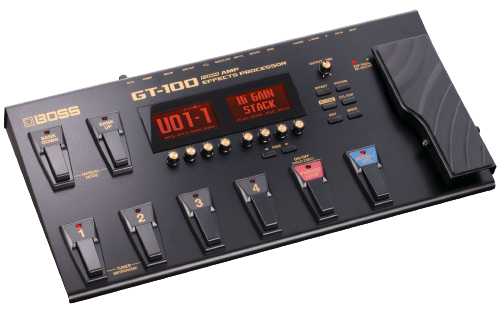
Multi-effects units, on the other hand, are all-in-one devices that contain multiple effects in a single unit. They often come with a variety of presets and settings that allow you to achieve a range of sounds without having to purchase multiple pedals.
Pros of using multi-effects units include:
- All-in-one solution that saves space on your pedalboard
- Easy to use and adjust settings
- Often come with a variety of presets and effects to choose from
- Can be more affordable than purchasing multiple pedals
However, there are also some cons to using multi-effects units:
- Limited customization options compared to individual pedals
- Some units may not produce the same high-quality sound as individual pedals
- Upgrading or replacing individual effects within the unit can be difficult or impossible
Ultimately, the decision between guitar pedals and multi-effects units comes down to personal preference and the type of sound you are trying to achieve. It’s worth experimenting with both options to see which one works best for you.
Guitar Pedals v Multi-Effects Units
When it comes to choosing between guitar pedals and multi-effects units, it can be a tough decision for beginners. Both options have their pros and cons, and ultimately, it comes down to personal preference and the type of sound you are trying to achieve.
Essential Pedals for Beginners
If you’re just starting with electric guitar pedals, it can be overwhelming to know where to start. Here are some essential pedals to consider for beginners:
Tuner Pedal
A tuner pedal is a must-have for any beginner guitarist. It helps you tune your guitar accurately and quickly, which is essential for good sound quality. Look for a pedal that’s easy to use and has a clear display, such as the Boss TU-3 or the Mooer Baby Tuner.
Overdrive Pedal
An overdrive pedal is a great first pedal for beginners. It can add some warmth and grit to your sound without being too overpowering. The NUX Steel Singer Drive and the Boss BD-2 Blues Driver are both great options to consider.
Delay Pedal
A delay pedal can add some depth and space to your sound. It’s a fun pedal to experiment with and can help you create some interesting sounds. The JHS 3 Series Delay and the Electro-Harmonix Neo Clone are both solid options for beginners.
Reverb Pedal
A reverb pedal can add some ambiance to your sound. It’s a great pedal to have if you’re playing in a large room or hall. The Electro-Harmonix Holy Grail Nano and the TC Electronic Hall of Fame Mini are both great options to consider.
Volume Pedal
A volume pedal can be used to control the volume of your guitar. It’s a versatile pedal that can be used for volume swells, fading in and out, and more. The Ernie Ball VP Jr. and the Boss FV-30L are both great options for beginners.
These are just a few essential pedals to consider for beginners. Of course, there are many other pedals out there to explore, such as distortion pedals, fuzz pedals, chorus pedals, and more. But with these pedals, you’ll have a solid foundation to build upon as you explore the world of guitar pedals.
Affordable and Reliable Pedal Brands
When it comes to buying electric guitar pedals, beginners often look for affordable and reliable options. Luckily, many brands offer great quality pedals at a reasonable price. Here are some of the most popular affordable and reliable pedal brands:
Boss Pedals
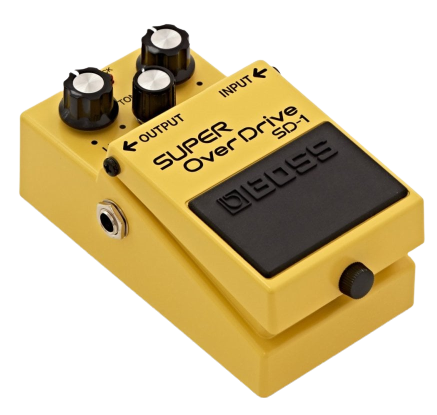
Boss is a well-known brand that offers a wide range of affordable and reliable pedals. Some of their most popular pedals include the Boss TU-3 Chromatic Tuner, the Boss SD-1 Super Overdrive, and the Boss GE-7 Graphic Equalizer.
These pedals are known for their durability and consistency, making them a great choice for beginners.
Mooer Pedals
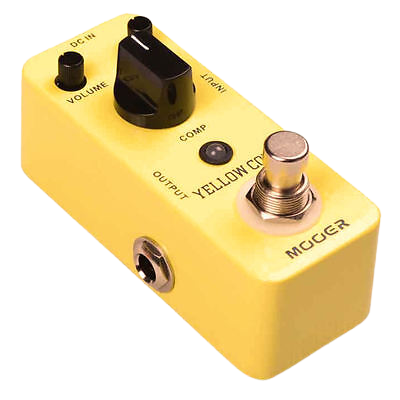
Mooer is a newer brand that has gained popularity in recent years for its affordable and compact pedals. Despite their small size, these pedals offer great sound quality and reliability.
Some popular Mooer pedals include the Mooer Yellow Comp Optical Compressor and the Mooer Blues Crab Overdrive.
Digitech Pedals
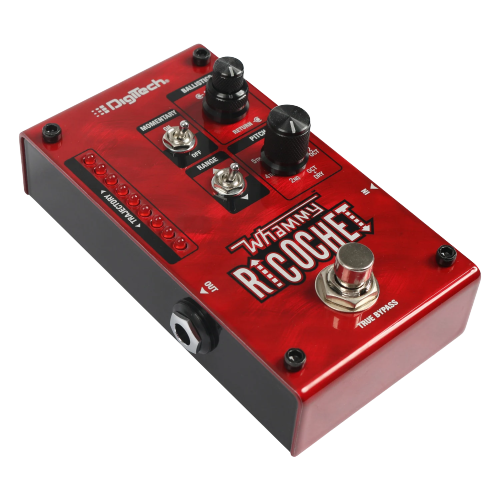
Digitech is another brand that offers affordable and reliable pedals. Their pedals are known for their versatility and ease of use.
Some popular Digitech pedals include the Digitech RP360XP Multi-Effects Processor and the Digitech Whammy Ricochet Pitch Shift Pedal.
Other Popular Pedals
Aside from the above brands, some individual pedals are known for their affordability and reliability. These include the ProCo Rat 2 Distortion Pedal, the Electro-Harmonix Nano Big Muff Distortion Pedal, the Ibanez Tube Screamer Overdrive Pedal, the Dunlop Crybaby Wah Pedal, and the Fulltone OCD Overdrive Pedal. Additionally, the Zoom G1X Four Multi-Effects Pedal is a great option for beginners who want to experiment with different effects without breaking the bank.
Overall, there are plenty of affordable and reliable options when it comes to electric guitar pedals. By choosing a pedal from one of the above brands, you can be sure that you’re getting a quality product without spending too much money.
Understanding the History of Pedals
If you’re new to the world of guitar pedals, it’s essential to understand the history of these devices and how they have evolved over the years. The history of guitar pedals dates back to the 1930s when Paul Bigsby created his first vibrato bar that used a motor and pulleys to wobble the bridge. In the 1940s, he modified the vibrato system and removed the motor, resulting in a design that has changed little over the years.
In the early days of music history, guitarists had to modify the sound they produced by creative means. They would resort to many extreme measures, such as cutting speaker cones, using different types of microphones, and even recording in different rooms to achieve their desired sound. However, with the advent of guitar pedals, guitarists could manipulate their sound with a simple stomp of their foot.
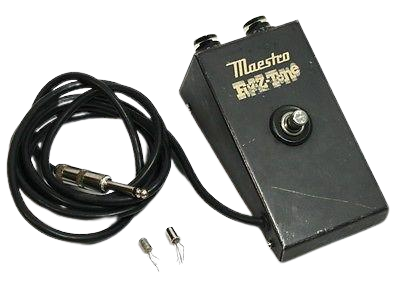
The first commercially available guitar pedal was the Maestro Fuzz-Tone, which was introduced in the early 1960s. This pedal was designed to replicate the sound of a distorted amplifier, and it quickly became a favourite of many guitarists, including Keith Richards of the Rolling Stones.
The Fuzz-Tone was followed by other pedals, such as the wah-wah, phaser, and flanger, which introduced guitarists to a whole new world of sound.
One of the most famous guitar pedals in history is the Big Muff, which was introduced in the 1970s. This pedal was designed to create a thick, sustaining distortion that was perfect for playing heavy rock and metal. The Big Muff was used by many famous guitarists, including David Gilmour of Pink Floyd, and it has become a staple of many guitarists’ pedalboards.
Over the years, guitar pedals have continued to evolve, with new designs and features being introduced all the time. Some of the most popular pedals today include the overdrive, delay, and reverb pedals, which are essential for creating a wide range of sounds. Whether you’re a beginner or an experienced guitarist, understanding the history of guitar pedals is essential to getting the most out of your playing.
Additional Resources and Buying Advice
When it comes to buying electric guitar pedals, there are several things to keep in mind to ensure you get the best bang for your buck. Here are some buying tips to help you make an informed decision:
- Consider versatility: Look for pedals that offer a range of effects, such as tremolo, flanger, and chorus. This will give you more options when it comes to creating your sound.
- Ease of use: Make sure the pedal is easy to use and navigate. Some pedals can be quite complex, so it’s important to find one that suits your skill level.
- Punch and cream: Look for pedals that can add punch and cream to your sound. These effects can really help your guitar stand out in a mix.
- Check out online resources: Websites like Sweetwater offer a wealth of information on different pedals, including user reviews and demos. Take advantage of these resources to get a better idea of what to expect from a particular pedal.
- Use a phone app: Some manufacturers offer phone apps that allow you to tweak your pedal settings and save presets. This can be a useful tool when it comes to fine-tuning your sound.
- Consider multi-effects pedals: If you’re just starting, a multi-effects pedal can be a great investment. These pedals offer a range of effects in one unit, making them a great option for beginners.
When it comes to choosing the right pedal for you, it’s important to take your time and do your research. Don’t be afraid to try out different pedals and see what works best for your particular style and needs.
In terms of utility and tools, it’s worth considering pedals that offer dynamics and time-based effects. These can help add depth and dimension to your sound and can be particularly useful when it comes to recording.
Ultimately, the key to finding the right pedal is to experiment and have fun with it. Whether you’re looking for a subtle effect or something more extreme, a pedal can help you achieve the sound you’re after.
Frequently Asked Questions
What is the difference between acoustic and electric guitar pedals?
Acoustic guitar pedals are designed to enhance the natural sound of an acoustic guitar, while electric guitar pedals are designed to modify the sound of an electric guitar. Acoustic guitar pedals typically include effects such as reverb, chorus, and delay, while electric guitar pedals include effects such as distortion, overdrive, and wah-wah.
Which guitar pedal brands are known for producing high-quality pedals?
Some of the most popular guitar pedal brands known for producing high-quality pedals include Boss, TC Electronic, Electro-Harmonix, MXR, and Strymon. These brands offer a wide range of pedals that cater to different playing styles and genres.
Are guitar pedals necessary for beginners?
Guitar pedals are not necessary for beginners, but they can greatly enhance the sound and versatility of your playing. As a beginner, it is important to focus on developing your technique and playing skills before investing in pedals. However, if you are interested in experimenting with different sounds and effects, pedals can be a fun and creative tool to add to your playing.
What are some essential guitar pedals for beginners?
Some essential guitar pedals for beginners include a tuner pedal, a distortion pedal, a delay pedal, and a reverb pedal. These pedals can help you create a wide range of sounds and effects and are a great starting point for building your pedalboard.
What should a beginner guitarist consider when choosing their first guitar pedal?
When choosing your first guitar pedal, it is important to consider your playing style, the type of music you play, and your budget. You should also consider the quality and durability of the pedal, as well as its ease of use and versatility. It is also a good idea to read reviews and try out different pedals before making a purchase.
Conclusion
Congratulations, you have made it to the end of this guide to electric guitar pedals for beginners! By now, you should have a good understanding of the different types of pedals available and how they can be used to enhance your playing.
Remember, when starting out with pedals, it’s best to start with just a few and gradually build up your collection. Don’t be afraid to experiment and find the sounds that work best for you.
Here are some key takeaways from this guide:
- There are many different types of pedals available, each with its own unique sound.
- Overdrive and distortion pedals are great for adding grit and crunch to your sound.
- Delay and reverb pedals can add depth and space to your playing.
- Modulation pedals like chorus and phaser can create interesting and complex sounds.
- Wah and volume pedals can add expression and dynamics to your playing.
When shopping for pedals, it’s important to consider your budget and the specific sounds you want to achieve. Don’t be swayed by fancy features or brand names – the most important thing is finding pedals that work for you and your playing style.
Finally, don’t forget to have fun! Pedals are a great way to explore new sounds and take your playing to the next level. With a little experimentation and practice, you’ll be a pedal pro in no time.
